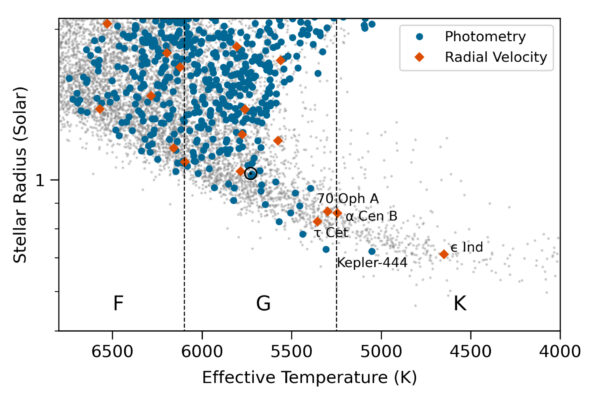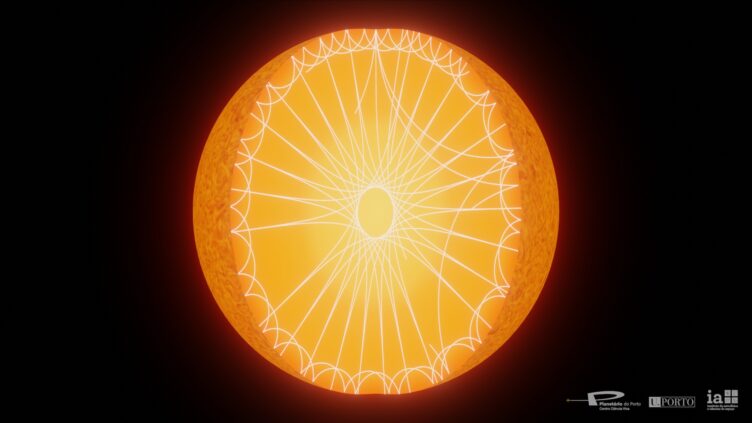At a distance of 11.9 light years, Epsilon Indi (ε Indi) is an orange dwarf star (also known as a K dwarf) with 71% of the Sun’s diameter. An international team1, led by Instituto de Astrofísica e Ciências do Espaço (IA2) reseacher Tiago Campante, studied this star with the ESPRESSO spectrograph, mounted at the European Southern Observatory’s (ESO) Very Large Telescope (VLT), and detected3 the tiniest “starquakes” ever recorded.

The team used a technique dubbed asteroseismology4, which measures oscillations in stars. These provide indirect glimpses of stellar interiors, just as earthquakes tell us about Earth’s interior. In ε Indi, the peak amplitude of the detected oscillations is just 2.6 centimeters per second (about 14% of the Sun’s oscillation amplitude), which makes it the smallest and coolest dwarf star observed to date with confirmed solar-like oscillations.

These measurements are so precise that the detected speed is slower than the average speed of a sloth! “The extreme precision level of these observations is an outstanding technological achievement. Importantly, this detection conclusively shows that precise asteroseismology is possible down to cool dwarfs with surface temperatures as low as 4200 degrees Celsius, about 1000 degrees cooler than the Sun’s surface, effectively opening up a new domain in observational astrophysics”, comments Campante, leader of the “Towards a comprehensive study of stars” research group at IA and assistant professor at the Dept. of Physics and Astronomy of the Science Faculty of the University of Porto (DFA–FCUP).
This level of precision might help scientists settle a long-standing disagreement between theory and observations in what concerns the relation between the mass and the diameter of these cool-dwarf stars. “Stellar evolution models are known to underestimate the diameter of K dwarfs by 5-15% compared to the diameter obtained from empirical methods. The study of oscillations in K dwarfs, via asteroseismology, will help identify the deficiencies of current stellar models and, thus, improve them, so as to eliminate this discrepancy ”, explains IA researcher Margarida Cunha.
These “starquakes” can now be used to help plan the future European Space Agency’s (ESA) PLATO space telescope, a mission in which IA is strongly involved. The oscillation amplitudes measured in this study can be converted to amplitudes in photometry, as they will be measured by PLATO, this being a key piece of information to help accurately predict the seismic yield of PLATO, scheduled to be launched in 2026.
“Every time we open a new window into nature, new surprises drive us into new unexpected discoveries. ε Indi holds the promise of being such a window with a bright view.”
Mário João Monteiro
Despite some initial skepticism that the detection of such oscillations could be beyond the reach of our current instrumental capabilities, Mário João Monteiro (IA & DFA-FCUP) explains that: ”Further to detecting the presence of solar-like oscillations in ε Indi, we now hope to use the oscillations to study the complex physics of the surface layers in K dwarfs. These stars are cooler and more active than our Sun, making them important laboratories to probe key phenomena taking place at their surface layers that we have not yet studied in detail in other stars.”
On why the team used ESPRESSO, Nuno Cardoso Santos (IA & DFA-FCUP), leader of the “Towards the detection and characterization of other Earths” research group at IA, said: “The ESPRESSO spectrograph has been developed by an international consortium co-led by IA. The main goals of ESPRESSO are to detect and characterize low-mass planets orbiting other stars, and to study the variability of the physical constants of nature. This result shows the potential of the ESPRESSO spectrograph to study other state-of-the-art science cases”.
Since orange dwarf stars and their planetary systems have very long lifespans, they have recently become a primary focus in the search for habitable worlds and extraterrestrial life. This result demonstrates that the power of asteroseismology can now potentially be put to use in the detailed characterization of such stars and their habitable planets, with truly far-reaching implications. Moreover, the precise determination of the ages of nearby cool dwarfs made possible by asteroseismology may be critical in interpreting biosignatures in directly imaged exoplanets.
Notes
- The team is: T. L. Campante , H. Kjeldsen, Y. Li , M. N. Lund , A. M. Silva, E. Corsaro, J. Gomes da Silva , J. H. C. Martins, V. Adibekyan, T. Azevedo Silva, T. R. Bedding, D. Bossini, D. L. Buzasi, W. J. Chaplin, R. R. Costa, M. S. Cunha, E. Cristo, J. P. Faria, R. A. García, D. Huber, M. S. Lundkvist, T. S. Metcalfe, M. J. P. F. G. Monteiro, A. W. Neitzel, M. B. Nielsen, E. Poretti, N. C. Santos & S. G. Sousa.
- The Instituto de Astrofísica e Ciências do Espaço (Institute of Astrophysics and Space Sciences – IA) is the reference Portuguese research unit in this field, integrating researchers from the University of Lisbon, the University of Coimbra and the University of Porto, and encompasses most of the field’s national scientific output. It was evaluated as “Excellent” in the last evaluation of research and development units undertaken by Fundação para a Ciência e a Tecnologia (FCT). IA’s activity is funded by national and international funds, including FCT/MCES (UIDB/04434/2020 e UIDP/04434/2020).
- The article “Expanding the frontiers of cool-dwarf asteroseismology with ESPRESSO: Detection of solar-like oscillations in the K5 dwarf ε Indi”, was published today in the journal Astronomy & Astrophysics Letters vol.683, L16 (DOI: 10.1051/0004-6361/202449197).
- Asteroseismology is the study of stellar interiors by measuring seismic oscillations at the star’s surface, much like an echogram allows us to see the inside of our body. In seismology, the different vibration modes from an earthquake can be used to study the Earth’s interior, in order to get data from the composition and depth of its different layers. In a similar fashion, oscillations at the star’s surface can be used to infer its internal structure and composition. This and other stellar astrophysics subjects are discussed in an interactive App, aimed at non-specialists, available here.
Contacts
Tiago Campante, Margarida Cunha, Mário João Monteiro
Science Communication Group
Ricardo Cardoso Reis; Sérgio Pereira; Filipe Pires (coordenação, Porto); João Retrê (coordenação, Lisboa)


